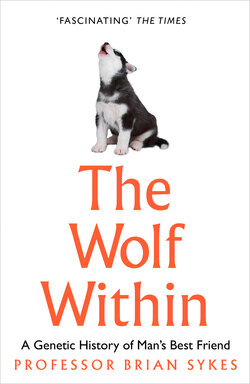Читать книгу The Wolf Within - Professor Bryan Sykes - Страница 12
Оглавление4
The genetic trees drawn with the help of mitochondrial DNA and the Y-chromosome make it very clear that the only ancestor of all dogs is the wolf. There is more we can decipher from the DNA results, but before we come to that, what do we know about the ancestry of wolves?
The Age of the Mammals began in the Cretaceous period following the sudden extinction of the dinosaurs some 65 million years ago. This extinction left a big gap in the fauna which was gradually filled by mammals, which until then had been an inconspicuous group of small furry animals cowering in the undergrowth. Their numbers increased, and by 40 million years ago, during the Eocene epoch, the emerging mammals began to evolve into today’s familiar groups: horses, deer, elephants, apes, dogs and cats, early forms of modern Orders.
Wolves, and therefore dogs, belong to the last of these Orders, the Carnivora. It has become the most diverse of any Order, embracing over 280 species, and it takes its name from the Latin that describes the main characteristic of its members: ‘flesh-eating’. They are the carnivorans, as distinct from the general term ‘carnivores’, which takes in all meat-eating species, be they fish, reptiles or even plants. A major division of the Order Carnivora is the Family Canidae, which includes wolves, coyotes, jackals and foxes. Cats large and small belong to the Family Felidae, bears and pandas to the Ursidae, while badgers, hyenas and seals belong to other, separate, families. Some carnivorans, like the Giant Panda, are strictly vegetarian but are still included within the same Order. It is their teeth that set the Carnivora apart from other mammalian Orders. All have well-developed third incisors, which serve to pierce the flesh of prey animals to prevent escape and to kill, while unique to carnivorans are their fearsome carnassial teeth, taking the place of our molars. Carnassial teeth are razor sharp and self-sharpening and are designed to slice through flesh like a pair of shears rather than merely tearing at it.
The dog-like carnivorans, the Canidae, and the cat-like Felidae began to diverge from each other and become gradually more specialised. As far as we can tell from the fossil record, the earliest canids evolved in North America where the oldest fossil dog, Cynodesmus, was discovered in Nebraska, USA, and lived between 33 and 26 million years ago. At one metre in length, it resembled a modern coyote and, by its dentition, was clearly carnivorous with large canine teeth for grasping and tearing the flesh of its prey. Soon after, on an evolutionary timescale, some truly fearsome carnivores began to evolve, including the bone-crushing Cynarctus. As these monsters became extinct about 11 million years ago they were replaced in turn by other canids, notably Tomarctus, found all over North America from Florida, north to Montana, west to California and south to Panama. From the size of the jaw muscle insertions in their skulls it is clear that Tomarctus had a bite strength far greater than required to kill its prey. This led to the conclusion that, like modern-day hyenas, Tomarctus was able to crush bones to reach the nutritious marrow of scavenged carcasses.
By the middle of the Miocene epoch, some 10 million years ago, the canids had spread from America, first to Asia, then to Europe and finally to Africa. As they did so, the ancestors of today’s wolves gradually evolved towards a lighter, faster frame in order to hunt swift herding prey like elk and wild horse. They hunted not as individuals but as members of a pack. Thus began the key development in the evolution of the modern wolf, and ultimately of the domestic dog. To be effective hunters they developed the ability to communicate with each other and to work as a team. Wolf packs travelled with the herds, following them throughout the year, a habit that our own human ancestors adopted.
